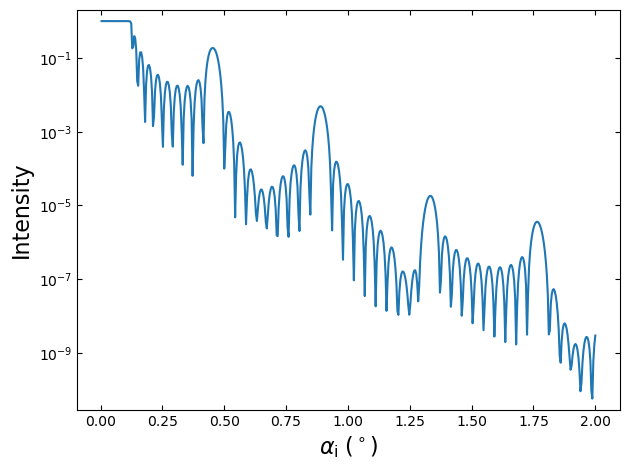1
2
3
4
5
6
7
8
9
10
11
12
13
14
15
16
17
18
19
20
21
22
23
24
25
26
27
28
29
30
31
32
33
34
35
36
37
38
39
40
41
42
43
44
45
46
47
48
|
#!/usr/bin/env python3
"""
Example of simulating a reflectometry experiment
with a rough sample using BornAgain.
"""
import bornagain as ba
from bornagain import angstrom, ba_plot as bp, deg, nm
def get_sample():
# Materials
vacuum = ba.MaterialBySLD("Vacuum", 0, 0)
material_ti = ba.MaterialBySLD("Ti", -1.9493e-06, 0)
material_ni = ba.MaterialBySLD("Ni", 9.4245e-06, 0)
material_substrate = ba.MaterialBySLD("SiSubstrate", 2.0704e-06, 0)
# Layers
ambient_layer = ba.Layer(vacuum)
ti_layer = ba.Layer(material_ti, 30*angstrom)
ni_layer = ba.Layer(material_ni, 70*angstrom)
substrate_layer = ba.Layer(material_substrate)
roughness = ba.LayerRoughness(1*nm)
# Sample
sample = ba.MultiLayer()
sample.addLayer(ambient_layer)
for _ in range(10):
sample.addLayerWithTopRoughness(ti_layer, roughness)
sample.addLayerWithTopRoughness(ni_layer, roughness)
sample.addLayerWithTopRoughness(substrate_layer, roughness)
return sample
def get_simulation(sample):
n = 500
scan = ba.AlphaScan(n, 2*deg/n, 2*deg)
scan.setWavelength(1.54*angstrom)
return ba.SpecularSimulation(scan, sample)
if __name__ == '__main__':
sample = get_sample()
simulation = get_simulation(sample)
result = simulation.simulate()
bp.plot_simulation_result(result)
|
